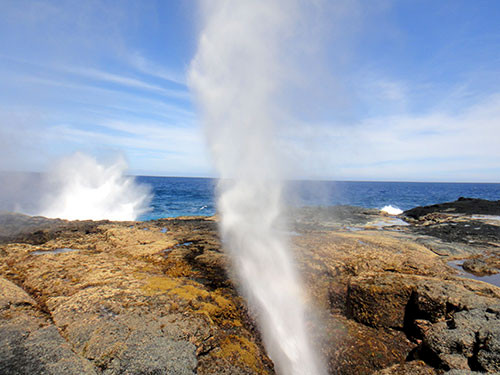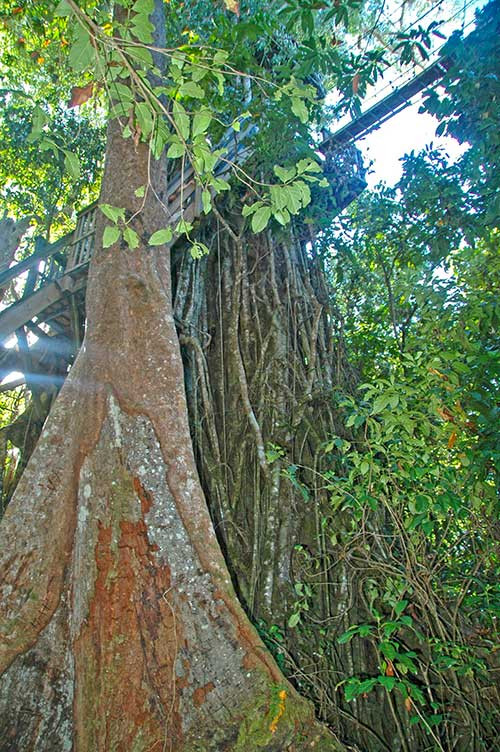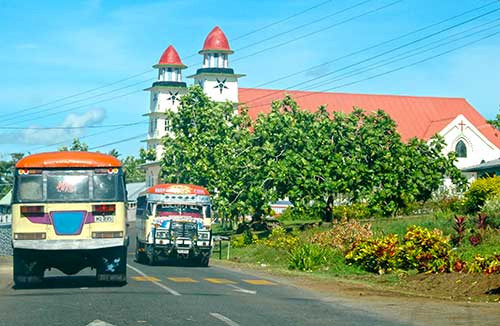Savai'i Island, Samoa; lava, blowholes, pigs, churches
Bill Dennison ·The trip around Savai'i Island passed through dozens of small villages that intercept the single road that largely follows the coastline. Each village had one to several large churches with immaculately kept grounds and a painted empty propane tank hanging out front. The propane tanks serve as the church bells to call people to the services. Sunday morning services are followed by a big family meal, a snooze in an open fale' (a covered concrete platform which is a communal living area), and then an evening service. Up to twenty Samoan women were often gathered in a fale' busy making fishing nets, sewing or weaving.

Many of the villages had a communal swimming pool at the mouth of a stream that was actively being used for bathing and washing clothes. People bathed either clothed or with bathing suits, and I suspect the sexual mores of Samoans are quite different than when Margaret Mead studied them.
The typical Samoan house had several structures; an open fale' out in front near the road, a small house with walls behind the fale' and an outhouse in back. In the front or side yard, there often was a large raised monument in which a departed family member was interred. The monuments were often used for drying laundry or for sitting on. The wash hanging on the clotheslines emphasized the colorful styles that the Samoas wore. The yards were always well kept, even if it meant sweeping the dirt. There were chickens wandering about in every village, and lots of small pigs rooming about. The cows and horses that were grazing were usually but not always tethered. Driving in Samoa was at a leisurely pace. In addition to people and animals walking on the roads, there are frequent large speed bumps to slow traffic.
One of the early names for the Samoan archipelago was the 'Navigator Islands', based on the ability of Samoans to navigate open sea passages with small dugout outrigger canoes and rudimentary navigational tools. However, today, most of the outrigger canoes are derelict and we saw very few boats in the water. Most of the Samoans on the ferry to Savai'i were seasick, and their ability to lay down on hard surfaces developed in the fale's was evident aboard the ferry, as there were Samoans sprawled out everywhere on the ferry decks. The boats that seemed most in use were aluminum double hulled boats with outboard motors.
The lava flows were extensive on Savai'i and in some places the houses and fale's were built directly on the black lava. The caves and lava tubes created at the shoreline led to some impressive blowholes. On the windward side of Savai'i, the fringing reef is either absent or submersed too deep to stop the ocean swell, so the impact of the waves on the lava coast results in spectacular blowholes. Seawater rushes into the caverns and forces its way up to the lava surface, creating a powerful waterspout. We threw coconuts into the blowholes just as the wave hit and the coconut was tossed 100 feet into the air.

We stopped off at a rainforest park in Northwest Savai'i and climbed a tower that had a walkway over to a large strangler fig with a platform that looked out over the top of the forest. Dead treetops were visible from a previous cyclone that had destroyed the forest, with a new tree canopy forming below. This park was created by Dr. Paul Alan Cox, a former seagrass colleague of mine who has had a long standing conservation role in Samoa.

We saw many small marine protected areas marked off with white bouys in the reef flat as will circumnavigated Savai'i. Judging by the uniform small size of fish that I observed both in the water within and alongside the protected areas and the small fish in the markets, I suspect these protected areas are either too small and/or poorly enforced.
I was impressed with the broad smiles and friendly people that we met on Samoa. The wonderful singing that we heard coming from the churches, the beautiful and colorful clothes that people wore, the lush vegetation and pretty flowers, and the leisurely pace of life make Samoa a particularly attractive place to visit. Apart from the presence of modern televisions and electricity, one could imagine what Robert Louis Stevenson experienced when he settled in Samoa in the nineteenth century.

About the author
Bill Dennison

Dr. Bill Dennison is a Professor of Marine Science and Vice President for Science Application at the University of Maryland Center for Environmental Science.